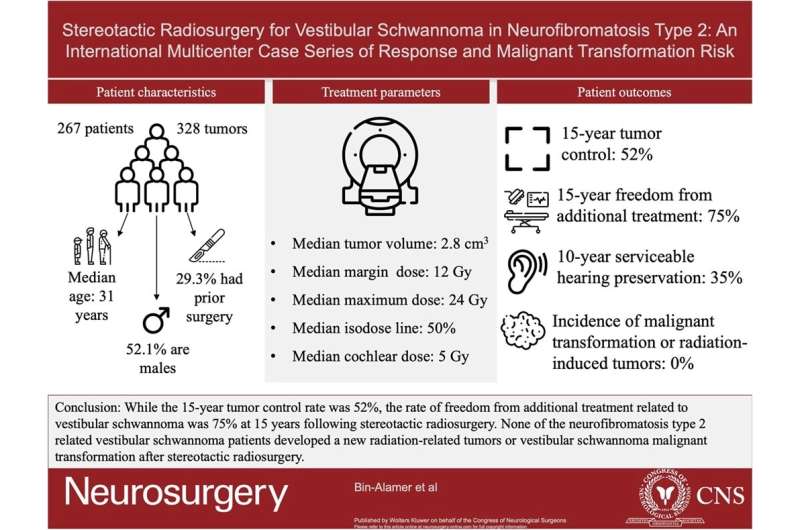
Vestibular schwannomas related to neurofibromatosis type 2 (NF2) are difficult to manage and are sometimes treated with a noninvasive option, stereotactic radiosurgery. A retrospective study conducted by an international, multicenter team found that stereotactic radiosurgery is effective for patients with these tumors while preserving serviceable hearing and not causing radiation-related tumor development or malignant transformation.
These results are reported in the journal Neurosurgery.
NF2 is a genetic condition that results in the growth of tumors of the brain, spinal cord, and peripheral nerves. A vestibular schwannoma (also known as acoustic neuroma, acoustic neurinoma, or acoustic neurilemoma) develops from the nerves of the inner ear that control balance and hearing.
Many people with NF2 develop vestibular schwannomas in both ears that are very difficult to manage, often requiring multiple surgeries and/or other procedures. Vestibular schwannomas can lead to hearing loss, facial weakness or numbness, and in large tumors, compression of cranial nerves and the brainstem leading to weakness, disequilibrium, difficulty swallowing, and hydrocephalus.
To better understand the effectiveness and safety of stereotactic radiosurgery for NF2-related vestibular schwannomas, Hussam Abou-Al-Shaar, MD, of the University of Pittsburgh Medical Center in Pittsburgh, Pennsylvania, and colleagues reviewed data on 267 patients (328 vestibular schwannomas) who underwent single-session stereotactic radiosurgery at 12 centers across the world.
Tumor control rates were high, and most patients did not require additional treatment.
The researchers report multiple positive outcomes:
- Tumor control likelihood of 77% at 10 years and 52% at 15 years
- Likelihood of not requiring additional treatment of 85% at 10 years and 75% at 15 years
- Likelihood of preserving serviceable hearing of 64% at five years and 35% at 10 years
The only significant predictor of tumor progression was tumor volume, with each one cm3 increase in tumor volume increasing the relative risk of tumor progression by 8%. The tumor progression rate was 48% at 15 years after stereotactic radiosurgery, but only 25% of patients required additional treatment by that time point, suggesting that despite radiographic progression, only half merited treatment.
Significant predictors of loss of serviceable hearing were older age (3% greater risk per year of age after stereotactic radiosurgery) and presence of bilateral vestibular schwannomas (4.56 times greater risk).
The procedure was not associated with radiation-related tumor development or malignant transformation
Dr. Abou-Al-Shaar and his colleagues report that during the median 59 months of follow-up, “We did not observe any event of radiation-induced tumor development or NF2-associated vestibular schwannoma malignant transformation.”
This has been a concern in patients with NF2 given their underlying propensity to develop tumors. The authors note that despite the benefits of stereotactic radiosurgery and its good safety profile, its use in patients with NF2 “…remains an area of controversy and concern among physicians. We hope that the findings of this study address some of these concerns.”
Dr. Abou-Al-Shaar’s group concludes that their results point to the need for early treatment of vestibular schwannoma in patients with NF2. “Tumor volume appeared to significantly impact tumor control and freedom from additional treatment, advocating for early stereotactic radiosurgery to maximize benefits and delay clinical deterioration.”
More information:
Othman Bin-Alamer et al, Stereotactic Radiosurgery for Vestibular Schwannoma in Neurofibromatosis Type 2: An International Multicenter Case Series of Response and Malignant Transformation Risk, Neurosurgery (2023). DOI: 10.1227/neu.0000000000002436
Journal information:
Neurosurgery
Source: Read Full Article